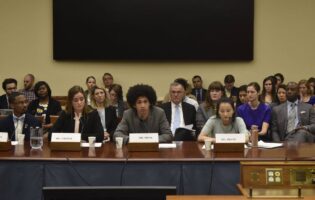Fracking and the Presidential Election: Drilling for Jobs

Kirsten Verclas
ORISE Science and Technology Policy Fellow
Kirsten Verclas is an ORISE Science and Technology Policy Fellow. Previously, she was a Program Manager in the International Department of the National Association of Regulatory Utility Commissioners (NARUC) working on regulatory partnerships in Africa under a NARUC-U.S. Agency for International Development (USAID) Cooperative Agreement. Before coming to NARUC, Ms. Verclas was a Senior Program Manager at the American Institute for Contemporary German Studies (AICGS) at Johns Hopkins University, where she managed the Institute’s grant projects. She initially joined AICGS as Executive Assistant in 2003 and started working in the Institute’s Research Program in 2008. Ms. Verclas has written extensively on energy and climate as well as security policy in the transatlantic context. She holds a BA in International Relations with a Minor in Economics from Franklin and Marshall College and an MA in International Relations with a concentration in Security Studies from The Elliott School at The George Washington University. She also earned an MS in Energy Policy and Climate from Johns Hopkins University in August 2013.
She is a 2017-2018 participant in AICGS’ project “A German-American Dialogue of the Next Generation: Global Responsibility, Joint Engagement,” sponsored by the Transatlantik-Programm der Bundesrepublik Deutschland aus Mitteln des European Recovery Program (ERP) des Bundesministeriums für Wirtschaft und Energie (BMWi).
On November 6, the U.S. presidential election will be decided in nine swing states: Virginia, Florida, Ohio, Wisconsin, Nevada, Colorado, Iowa, New Hampshire, and North Carolina, representing a crucial number of the necessary 270 Electoral College votes. The outcome in these swing states is still too close to predict. Other states, like Pennsylvania, considered a swing state in previous elections, are more certain (Pennsylania will likely vote for President Obama). Six swing (or near-swing) states are home to natural gas reserves—Colorado, Virginia, Ohio, Wisconsin, Pennsylvania, and Iowa—of which most are shale gas. Buried deep in the earth, shale gas reserves are not recoverable with conventional methods but are extracted by hydraulic fracturing, or “fracking.” During the process, fracking fluids (usually a mixture of water, sand, and chemicals) are injected into the shale gas plays, creating new fissures in the rock that allow natural gas to be extracted from rock pores in which it had previously been trapped. Although the U.S. government is trying to learn more about the chemicals used in the process, the precise components remain a mystery. Furthermore, researchers and analysts still know very little about the climate footprint (particularly about the release of methane), the impact of noise pollution, potential to cause seismic activities, and possible risks of air and groundwater pollution.
The development of fracking as a new technology created a boom in natural gas production in the United States. Shale gas production rapidly increased from about 0.2 trillion cubic feet in 2000 to about 4.3 trillion cubic feet in 2010.[1] Development of new gas fields is considered promising, particularly in the fields of the Marcellus shale, located in New York, Pennsylvania, Maryland, Virginia, and Ohio. The U.S. Energy Information Administration (EIA) projects that shale gas will make up 49 percent of natural gas produced in the U.S. by 2035.[2]
Fracking in the U.S. – A Job Creation Miracle?
Proponents of shale gas tout the job creation potential of this revitalized industry. States such as Pennsylvania and Ohio, which were especially hard-hit by the decline in manufacturing and steel production in the U.S., view the shale gas reserves as an opportunity for revitalization and create job creation. A study by the World Economic Forum and IHS CERA argues that “the shale gas industry alone employs 600,000 people in the United States, with an additional 400,000 employed in the production of tight gas and coal seam gas.”[3] An earlier study by IHS Global Insights estimated that “approximately 2.8 million jobs could be attributed to the natural gas industry in 2008.”[4] The labor market benefits are clear in North Dakota. Although not a swing state, North Dakota is heralded as the state benefiting most from the new oil and gas boom: its unemployment rate was 3.3 percent in July 2012—the lowest in the nation. While not nearly as low, the employment picture in the swing states with natural gas reserves also looks rosier than in the rest of the nation: Ohio faced unemployment of 7.2 percent and Pennsylvania 7.9 percent in July. Both are below the national unemployment rate of 8.3 percent (for July 2012).
Setting aside the environmental aspect of this issue, the labor market perspective begs the question: What kind of jobs will be created? Based on first impressions, the jobs connected to the natural gas industry are relatively well-paid; however, they are also temporary and unstable. The workers are hundreds of miles from home and live in huge trailer parks. Due to the increased supply, the price of natural gas has decreased over the last decade in the U.S., falling to about $2/million BTUs in 2012. The international price, however, has increased dramatically—natural gas in Japan rose to over $15/million BTUs in the summer of 2012.[5] Due to the discrepancy between the international and national gas prices, natural gas producers are interested in potentially exporting American natural gas overseas; however, technological questions have to be solved first. Additionally, the decreasing domestic natural gas price reveals the catch-22 between increased natural gas production and employment: Should the natural gas price continue to fall, the incentive to produce more natural gas will decrease, thereby preventing many companies from exploring natural gas extraction further. The low gas price has already led to a decline in natural gas wells.[6] Taking advantage of the high international gas price by increasing exports of national gas, provided the technological hurdles are cleared, will have a beneficial impact on employment numbers. However, the decreased availability of natural gas in the U.S. will cause domestic gas prices to rise, having an overall dampening effect on the U.S. economy. This is why it is especially important to create jobs in fields that are less dependent on the boom and bust cycle of natural gas.
The existing oil infrastructure cannot be transferred 1:1 to the natural gas production routes, and investment in refurbishment and new transportation methods are needed. On the one hand, this seems to be an argument supporting natural gas extraction, as more jobs are created through modernizing the infrastructure. On the other, this requires not only financial investments, but also qualified workers. The greatest challenge of the twenty-first century, aside from handling demographic changes, is the management of technological advances. Two possible scenarios for managing technological advances exist:
1) The increased development of the natural gas fields leads to the creation of a labor market for low and unqualified workers. In this scenario, natural gas is produced with as much manpower as possible and any consideration of environmental protection is disregarded. This requires a laissez-faire approach and a nation that is eager to accept high risks for the collective population and does not control or regulate gas production.
2) Natural gas is extracted in a controlled and regulated policy environment under strict supervision by the authorities. Contrary to popular assumption, new jobs can be created in this scenario as well. These jobs are clearly differentiated from the usual laborers who prepare gas reserves for drilling with heavy machinery. Rather, highly specialized and highly qualified drilling engineers would be at work. Jobs in searching, drilling, and storing natural gas need highly qualified workers.[7] However, there is already a shortage of these workers and much needed traditional blue collar jobs would still be missing. So what does this all boil down to? Pursuing this scenario requires financial investment and an accompanying investment in educational qualifications.[8] Additionally, creating a regulated environment that does not succumb to the natural gas boom and gives equal weight to the modernization of the electrical grid and renewable energy takes time. Politically, that does not sell well. In general debates these points are usually dismissed as increasing the deficit; politicians prefer a quick fix to ensure energy supply.
However, the classic concept of the migrant worker, whether with a horse and wagon or a truck and trailer, is not forward-looking. Progress requires financial and labor market investment. President Obama was on the right track, but—so far—has not been able to prevail. Even though the natural gas boom overshadows the energy debate, it is not too late for a green New Deal. While one should not overestimate the number of new jobs created, as those jobs will be threatened by higher productivity and efficiency, updating the grid to use renewable energy would be accompanied by massive increases in productivity. This will surely attract further qualification efforts and lead to middle and long-term jobs.
The federal government has been slow to address the regulatory issues surrounding fracking; proponents of fracking have argued that the Clean Water Act, the Clean Air Act, and the National Environmental Policy Act already govern the practice sufficiently. Under President Obama, the U.S. Department of the Interior has begun to draft fracking regulations for publicly-owned land (on which 38 percent of natural gas reserves are located) and the EPA is also slowly tackling the issue. The Republican candidate Mitt Romney would like to see the states to oversee regulation without the EPA or other federal agencies becoming involved. [9]
Shale Gas in Germany – A More Cautionary Approach
Although the natural gas resources in Germany are only modest, the Federal Institute for Geosciences and Natural Resources estimates that about 81 trillion cubic feet of natural gas could be recovered through fracking and other technologies, constituting about 20 times the annual natural gas consumption in Germany.[10] As the country is phasing out nuclear energy by 2022 and grappling with the changes this will bring to its energy supply, skepticism on both the state and federal level dominates the debate about fracking. A recent study by the Federal Ministry for the Environment recommended allowing fracking only under very stringent regulations,[11] which analysts understood as an implicit ban. The German parliament will most likely take up the issue in winter 2012/2013, but the support of most parties for a ban is evident. The tradition and history of green issues in German politics is as old as the Green Party, which increased rapidly after the Chernobyl disaster in Europe.[12] Environmental issues are important aspects of political campaigning in Germany, and parties are able to garner significant support by putting environmental concerns on the agenda. Yet the widespread support for banning fracking makes this issue a non-starter for political controversy or debate in Germany’s federal election in 2013.
While the U.S. and Germany have arrived at a very different assessment on fracking for the moment, the controversy surrounding the issue makes it difficult to obtain non-partisan data, as well as expertise in evaluating the gains and risks of this growing technology in both countries. Germany can contribute to the job discussion, discussing its experiences in changing the energy sector in the last few years; many positive aspects as well as some negative lessons can be learned. [13] The coal industry in Germany came under pressure in the 1960s as overseas coal production became significantly cheaper. German coal mining was subsequently subsidized to make it more competitive on the world market, but these subsidies proved to be financially unsustainable and incompatible with European Union rules.
Consequently, the federal government and the German states agreed in 2001 to phase out subsidies for German coal mines until 2018, effectively ending German coal mining at that date. The over fifteen year-long phase-out is bolstered by social measures (for example, job and educational training) to prevent job losses and increased unemployment in states in which coal mining is currently present. Additionally, the development of the renewable energy sector has created many of the new jobs in Germany. Renewable energy has become a job creator, employing over 300,000 people already in 2009.[14] The industry is forecasting that over 500,000 jobs will be associated with renewable energies in Germany by 2020.[15]
The U.S. can also learn from initial mistakes Germany made in restructuring its energy sector. Most significantly, the liberalization of the energy market was initially carried out completely without regulation. This 1) cost a large sum of money, and 2) did not favor consumers, both private customers and businesses. Profits were not reinvested, but only paid out to shareholders. The federal government was prompted to undertake massive reforms, such as by reorganizing the duties of the Federal Network Agency (Bundesnetzagentur).
The lingering consequences of the recession in the U.S. and the financial crisis in Europe threaten to push environmental issues to the side. In these times of crisis, employment becomes the main factor of every major political debate. While transforming the energy sector and increasing renewable energy does not provide a quick fix to the job conundrum, the German example shows that with patience and sensible investment it can lead to sustainable job growth. In Germany a healthy environment is an important aspect of the quality of life and the ability to pass on a healthy environment to the next generation is highly valued. Perhaps this sounds naïve to American ears, especially in times of crisis. The claim that natural gas is the panacea for energy security and sustained job growth without significant ecological, environmental, and security risks, however, sounds just as naïve. Finding a source of energy that is also a source of economic growth and sustained employment has to go beyond the current natural gas boom. It requires patience, a regulatory commitment, financial resources, and public and private intuition and innovation, long after the sound bites of the presidential campaign have trailed off.
The authors would like to thank Jessica Riester for editing the essay, Rebecca Buhner for the translation and editorial work, Doug Murray for online bibliographical research, and Dr. Robert Nadeau for his insights. Dr. Carsten Weiß’ research stay at AGI was made possible by the NRW School of Governance Fellowship. The opinions expressed in this article are the authors alone, and they are responsible for any remaining errors.
[1] Jim Finnegan, What Shall We Do with All Our New Natural Gas, American Century Investments Blog, 3 April 2012, http://americancenturyblog.com/2012/04/what-shall-we-do-with-all-our-new-natural-gas
[2] U.S. Energy Information Administration, Energy in Brief, 9 July 2012, http://www.eia.gov/energy_in_brief/about_shale_gas.cfm
[3] World Economic Forum and IHS Cera, Energy for Economic Growth – Energy Vision Update 2012, , http://www3.weforum.org/docs/WEF_EN_IndustryVision.pdf
[4] Charles Davis, The Politics of “Fracking”: Regulating Natural Gas Drilling Practices in Colorado and Texas, Review of Policy Research, Volume 29, Number 2, 2012
[5] Jim Finnegan, What Shall We Do with All Our New Natural Gas, American Century Investments Blog, 3 April 2012, http://americancenturyblog.com/2012/04/what-shall-we-do-with-all-our-new-natural-gas/ and U.S. Energy Information Administration, Today in Energy, http://www.eia.gov/todayinenergy/detail.cfm?id=5970
[6] Travis Hoim, No End in Sight for Cheap Natural Gas, 8 August 2012, http://www.dailyfinance.com/2012/08/08/no-end-in-sight-for-cheap-natural-gas/
[7] See for example: Wirtschaftsverband Erdöl- und Erdgasgewinnung e. V., Beschäftigung in der E&P Branche, http://www.erdoel-erdgas.de/article/articleview/115/1/92/
[8] Bowen, Max (2012): ‘Green’ growth, ‘green’ jobs and labor markets. Washington, DC: 39 S. Reihe / Serie: World Bank policy research working paper Nr. 5990
[9] Brad Plummer, How States are Regulating Fracking (in Maps), The Washington Post, 16 July 2012 http://www.washingtonpost.com/blogs/ezra-klein/wp/2012/07/16/how-states-are-regulating-fracking-in-maps/
[10] Christian Wüst, Germany Balks on Natural Gas Bonanza, Der Spiegel, 5 October 2012, http://www.spiegel.de/international/business/safety-worries-lead-germany-to-shun-fracking-for-natural-gas-a-859446.html
[11] Federal Ministry for the Environment, Tight Restrictions on Hydrauklic Frackin Requried, Press Release, 6 September 2012, http://www.umweltbundesamt.de/uba-info-presse-e/2012/pe12-028_tight_restrictions_on_hydraulic_fracturing_required.htm
[12] Frankfurter Allgemeine Zeitung, Warum Klaus Töpfer Wirklich den Rhein Durchschwamm, 5 June 2006, http://www.faz.net/aktuell/wirtschaft/wirtschaftspolitik/20-jahre-umweltministerium-warum-klaus-toepfer-wirklich-den-rhein-durchschwamm-1331903.html
[13] Heinz-J. Bontrup and Ralf-M. Marquardt, Chancen und Risiken der Energiewende, Arbeitspapier 252, Hans-Böckler-Stiftung, March 2012, http://www.boeckler.de/pdf/p_arbp_252.pdf
[14] Renewable Energy: 300.000 jobs in 2009, BMU/AGEE-Stat, Status: 4/2010, http://www.unendlich-viel-energie.de/uploads/media/Erneuerbare-Arbeitsplaetze_englisch.pdf
[15] Development of jobs in the Renewable Energy sector, BMU/AGEE-Stat, DLR/ZSW/DIW/GWS, UBA Status: 4/2010, http://www.unendlich-viel-energie.de/uploads/media/Erneuerbare-steigendeArbeitsplaetze_englisch.pdf








